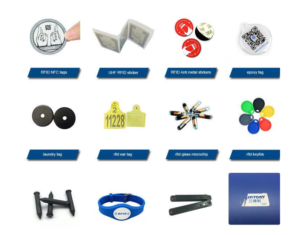
Efficient and reliable tracking systems are crucial for modern businesses aiming to optimize operations and enhance security. Radio Frequency Identification (RFID) technology is a revolutionary solution, offering significant benefits in inventory management, security, and operational efficiency. Let’s explore the different types of RFID tags, their specific use cases, and the advantages they provide across various industries.
Overview of RFID Tag Types
RFID tags come in three main types: passive, active, and semi-passive. Each type has unique features and applications, catering to different business needs and environments.
Passive RFID Tags
Passive RFID tags are the most common and economical type. They do not have an internal power source and rely on the electromagnetic energy transmitted from an RFID reader to power up and communicate. These tags are lightweight, small, and suitable for a wide range of applications.
Active RFID Tags
Active RFID tags contain an internal battery, allowing them to broadcast signals continuously. This capability extends their read range significantly, making them ideal for applications requiring real-time tracking and monitoring.
Semi-Passive RFID Tags
Semi-passive RFID tags, also known as battery-assisted passive (BAP) tags, combine features of both passive and active tags. They have a small battery that powers the tag’s circuitry but rely on the RFID reader for communication. This design enhances read range and reliability without the high costs associated with active tags.
Specific Use Cases for Each Type
Understanding the use cases for each RFID tag type helps businesses choose the right solution for their needs.
Use Cases for Passive RFID Tags
- Retail Inventory Management: Passive RFID tags are widely used in retail for tracking merchandise from the warehouse to the sales floor. This ensures accurate inventory counts and helps prevent stockouts and overstock situations.
- Library Systems: Libraries use passive RFID tags to manage books and other media. The tags streamline the check-in and check-out process, reduce theft, and simplify inventory audits.
- Event Management: Event organizers use passive RFID tags in tickets and badges to control access, manage attendee movements, and enhance security.
Use Cases for Active RFID Tags
- Asset Tracking: Active RFID tags are ideal for tracking high-value assets in large facilities such as hospitals, manufacturing plants, and construction sites. Their long-read range allows real-time location monitoring.
- Supply Chain Management: Active RFID tags enable continuous monitoring of goods in transit, providing real-time data on the location and condition of shipments. This enhances supply chain visibility and reduces losses.
- Security and Access Control: Active RFID tags are used in access control systems to manage entry and exit points in secure facilities. They guarantee that only authorized personnel can access restricted areas.
Use Cases for Semi-Passive RFID Tags
- Cold Chain Management: Semi-passive RFID tags are used in temperature-sensitive supply chains to monitor the conditions of perishable goods. The battery-powered sensors provide accurate temperature readings throughout transit.
- Environmental Monitoring: These tags are employed in environmental monitoring applications where real-time data on parameters like humidity and pressure is critical. Their enhanced read range and reliability make them suitable for remote monitoring.
- Logistics and Warehousing: Semi-passive RFID tags offer a cost-effective solution for tracking goods in large warehouses, ensuring efficient stock management and reducing the risk of misplaced items.

Benefits of Each RFID Tag Type in Various Industries
Benefits of Passive RFID Tags
- Cost-Effectiveness: Passive RFID tags are inexpensive, making them suitable for large-scale deployments.
- Versatility: Their small size and lightweight nature allow for diverse applications, from retail to libraries.
- Ease of Use: Passive tags require minimal maintenance and are easy to deploy, reducing operational overhead.
Benefits of Active RFID Tags
- Extended Read Range: Active RFID tags can be read from greater distances, making them ideal for real-time tracking over large areas.
- Real-Time Data: Continuous broadcasting of signals allows for instant data capture, essential for applications like asset tracking and supply chain management.
- Enhanced Security: The robust signal strength and reliability of active tags improve security and access control systems.
Benefits of Semi-Passive RFID Tags
- Improved Read Reliability: The internal battery enhances read range and reliability, ensuring accurate data capture even in challenging environments.
- Cost-Effective Monitoring: Semi-passive tags offer a middle ground between passive and active tags, providing extended features without the high costs of active tags.
- Versatile Applications: They are suitable for a wide range of applications, from environmental monitoring to logistics, offering flexibility to businesses.
Conclusion
RFID technology has revolutionized the way businesses confidently manage inventory, assets, and security. Understanding the different types of RFID tags—passive, active, and semi-passive—allows businesses to select the right solution for their specific needs. Each tag type offers unique benefits and is suited to various applications, enhancing efficiency, accuracy, and overall operational performance. As RFID technology continues to evolve, its adoption across industries is set to increase, driving further innovation and improvements in business processes.
By exploring the distinct characteristics and applications of RFID tags, businesses can make informed decisions that optimize their operations and provide a competitive edge in their respective markets.






